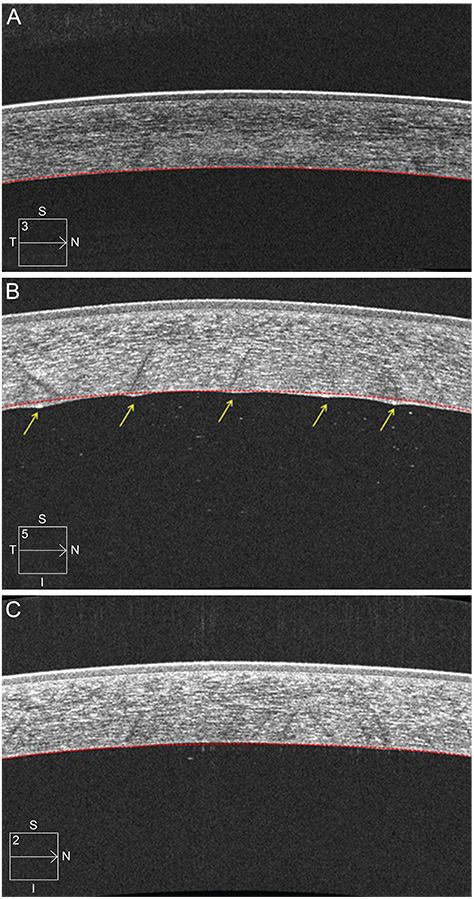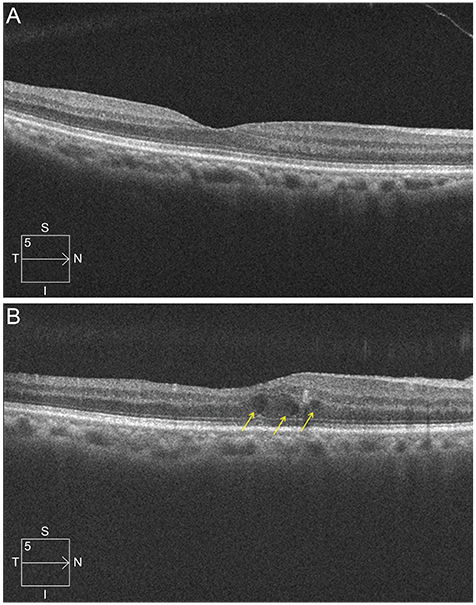Korean J Ophthalmol.
2015 Feb;29(1):14-22. 10.3341/kjo.2015.29.1.14.
Transient Corneal Edema is a Predictive Factor for Pseudophakic Cystoid Macular Edema after Uncomplicated Cataract Surgery
- Affiliations
-
- 1Department of Ophthalmology, Dongguk University Ilsan Hospital, Goyang, Korea. oph0112@gmail.com
- 2Department of Ophthalmology and Visual Sciences, Montefiore Medical Center, Albert Einstein College of Medicine, Bronx, NY, USA.
- KMID: 2360133
- DOI: http://doi.org/10.3341/kjo.2015.29.1.14
Abstract
- PURPOSE
To report transient corneal edema after phacoemulsification as a predictive factor for the development of pseudophakic cystoid macular edema (PCME).
METHODS
A total of 150 eyes from 150 patients (59 men and 91 women; mean age, 68.0 ± 10.15 years) were analyzed using spectral domain optical coherence tomography 1 week and 5 weeks after routine phacoemulsification cataract surgery. Transient corneal edema detected 1 week after surgery was analyzed to reveal any significant relationship with the development of PCME 5 weeks after surgery.
RESULTS
Transient corneal edema developed in 17 (11.3%) of 150 eyes 1 week after surgery. A history of diabetes mellitus was significantly associated with development of transient corneal edema (odds ratio [OR], 4.04; 95% confidence interval [CI], 1.41 to 11.54; p = 0.011). Both diabetes mellitus and transient corneal edema were significantly associated with PCME development 5 weeks after surgery (OR, 4.58; 95% CI, 1.56 to 13.43; p = 0.007; and OR, 6.71; CI, 2.05 to 21.95; p = 0.003, respectively). In the 8 eyes with both diabetes mellitus and transient corneal edema, 4 (50%) developed PCME 5 weeks after surgery.
CONCLUSIONS
Transient corneal edema detected 1 week after routine cataract surgery is a predictive factor for development of PCME. Close postoperative observation and intervention is recommended in patients with transient corneal edema.
MeSH Terms
-
Adult
Aged
Aged, 80 and over
Cornea/*pathology
Corneal Edema/*diagnosis/etiology
Female
Fluorescein Angiography
Follow-Up Studies
Fundus Oculi
Glucosinolates
Humans
Macular Edema/diagnosis/*etiology
Male
Middle Aged
*Phacoemulsification
Pseudophakia/*complications/diagnosis
Retrospective Studies
Tomography, Optical Coherence
Glucosinolates
Figure
Reference
-
1. Flach AJ. The incidence, pathogenesis and treatment of cystoid macular edema following cataract surgery. Trans Am Ophthalmol Soc. 1998; 96:557–634.2. Halpern DL, Pasquale LR. Cystoid macular edema in aphakia and pseudophakia after use of prostaglandin analogs. Semin Ophthalmol. 2002; 17:181–186.3. Henderson BA, Kim JY, Ament CS, et al. Clinical pseudophakic cystoid macular edema: risk factors for development and duration after treatment. J Cataract Refract Surg. 2007; 33:1550–1558.4. Loewenstein A, Zur D. Postsurgical cystoid macular edema. Dev Ophthalmol. 2010; 47:148–159.5. Belair ML, Kim SJ, Thorne JE, et al. Incidence of cystoid macular edema after cataract surgery in patients with and without uveitis using optical coherence tomography. Am J Ophthalmol. 2009; 148:128–135.6. Perente I, Utine CA, Ozturker C, et al. Evaluation of macular changes after uncomplicated phacoemulsification surgery by optical coherence tomography. Curr Eye Res. 2007; 32:241–247.7. Benitah NR, Arroyo JG. Pseudophakic cystoid macular edema. Int Ophthalmol Clin. 2010; 50:139–153.8. Setala K. Corneal endothelial cell density in iridocyclitis. Acta Ophthalmol. 1979; 57:277–286.9. Weston BC, Bourne WM, Polse KA, Hodge DO. Corneal hydration control in diabetes mellitus. Invest Ophthalmol Vis Sci. 1995; 36:586–595.10. O'sNeal MR, Polse KA. Decreased endothelial pump function with aging. Invest Ophthalmol Vis Sci. 1986; 27:457–463.11. Glasser DB, Schultz RO, Hyndiuk RA. The role of viscoelastics, cannulas, and irrigating solution additives in post-cataract surgery corneal edema: a brief review. Lens Eye Toxic Res. 1992; 9:351–359.12. Tao A, Chen Z, Shao Y, et al. Phacoemulsification induced transient swelling of corneal Descemet's Endothelium Complex imaged with ultra-high resolution optical coherence tomography. PLoS One. 2013; 8:e80986.13. Behndig A, Lundberg B. Transient corneal edema after phacoemulsification: comparison of 3 viscoelastic regimens. J Cataract Refract Surg. 2002; 28:1551–1556.14. Li YJ, Kim HJ, Joo CK. Early changes in corneal edema following torsional phacoemulsification using anterior segment optical coherence tomography and Scheimpflug photography. Jpn J Ophthalmol. 2011; 55:196–204.15. Zetterstrom C, Laurell CG. Comparison of endothelial cell loss and phacoemulsification energy during endocapsular phacoemulsification surgery. J Cataract Refract Surg. 1995; 21:55–58.16. Hayashi K, Nakao F, Hayashi F. Corneal endothelial cell loss following phacoemulsification using the Small-Port Phaco. Ophthalmic Surg. 1994; 25:510–513.17. Kosrirukvongs P, Slade SG, Berkeley RG. Corneal endothelial changes after divide and conquer versus chip and flip phacoemulsification. J Cataract Refract Surg. 1997; 23:1006–1012.18. Ersoy L, Caramoy A, Ristau T, et al. Aqueous flare is increased in patients with clinically significant cystoid macular oedema after cataract surgery. Br J Ophthalmol. 2013; 97:862–865.19. Shah SM, Spalton DJ. Changes in anterior chamber flare and cells following cataract surgery. Br J Ophthalmol. 1994; 78:91–94.20. Oh JH, Chuck RS, Do JR, Park CY. Vitreous hyper-reflective dots in optical coherence tomography and cystoid macular edema after uneventful phacoemulsification surgery. PLoS One. 2014; 9:e95066.21. Yonekawa Y, Kim IK. Pseudophakic cystoid macular edema. Curr Opin Ophthalmol. 2012; 23:26–32.22. Schmier JK, Halpern MT, Covert DW, Matthews GP. Evaluation of costs for cystoid macular edema among patients after cataract surgery. Retina. 2007; 27:621–628.23. Antcliff RJ, Poulson A, Flanagan DW. Phacoemulsification in diabetics. Eye (Lond). 1996; 10:737–741.24. Morikubo S, Takamura Y, Kubo E, et al. Corneal changes after small-incision cataract surgery in patients with diabetes mellitus. Arch Ophthalmol. 2004; 122:966–969.25. Hariprasad SM, Callanan D, Gainey S, et al. Cystoid and diabetic macular edema treated with nepafenac 0.1%. J Ocul Pharmacol Ther. 2007; 23:585–590.26. Wolf EJ, Braunstein A, Shih C, Braunstein RE. Incidence of visually significant pseudophakic macular edema after uneventful phacoemulsification in patients treated with nepafenac. J Cataract Refract Surg. 2007; 33:1546–1549.27. Miyake K, Ota I, Miyake G, Numaga J. Nepafenac 0.1% versus fluorometholone 0.1% for preventing cystoid macular edema after cataract surgery. J Cataract Refract Surg. 2011; 37:1581–1588.28. Stern AL, Taylor DM, Dalburg LA, Cosentino RT. Pseudophakic cystoid maculopathy: a study of 50 cases. Ophthalmology. 1981; 88:942–946.29. Rossetti L, Autelitano A. Cystoid macular edema following cataract surgery. Curr Opin Ophthalmol. 2000; 11:65–72.30. Shakya K, Pokharel S, Karki KJ, et al. Corneal edema after phacoemulsification surgery in patients with type II diabetes mellitus. Nepal J Ophthalmol. 2013; 5:230–234.
- Full Text Links
- Actions
-
Cited
- CITED
-
- Close
- Share
- Similar articles
-
- Pathophysiology of Transient Corneal Edema and Pseudophakic Cystoid Macular Edema
- Clinical Results of Nd:Yag Laser Posterior Capsulotomy
- A Case of Secondary Macular Hole Formation after Phacoemulsification in a Vitrectomized Eye
- Prophylactic Intracameral Vancomycin Irrigation and Cystoid Macular Edema
- Assessment for Macular Thickness after Uncomplicated Phacoemulsification Using Optical Coherence Tomography



